
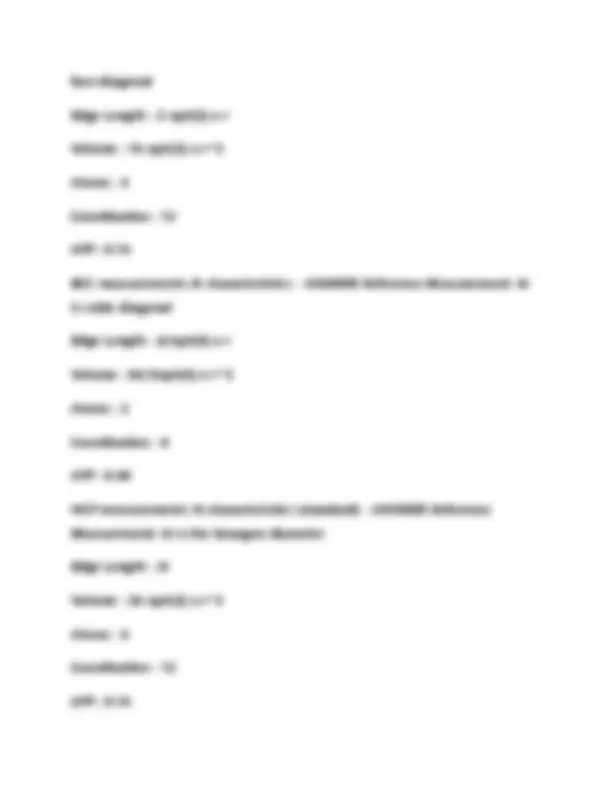
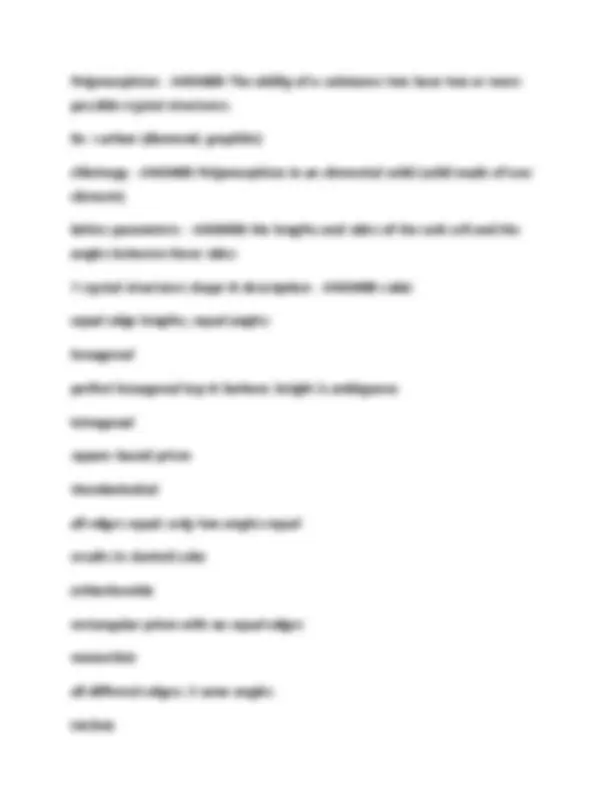
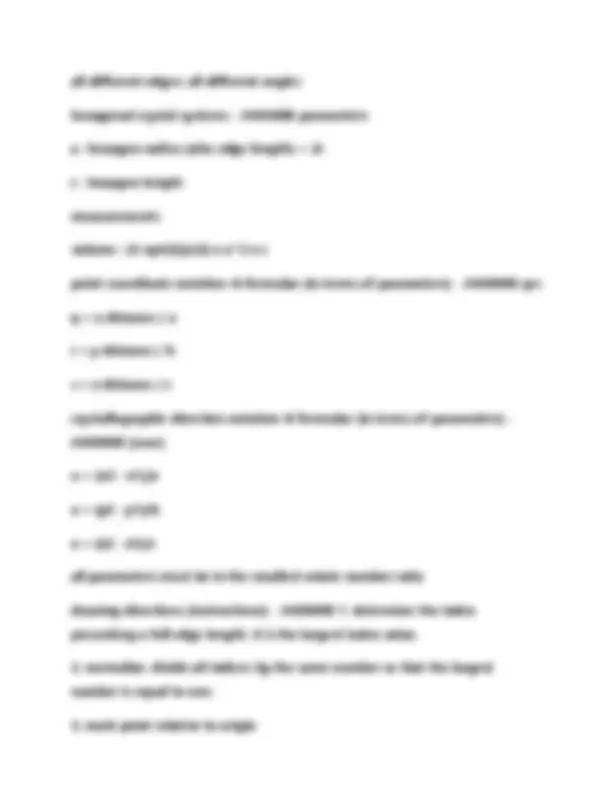
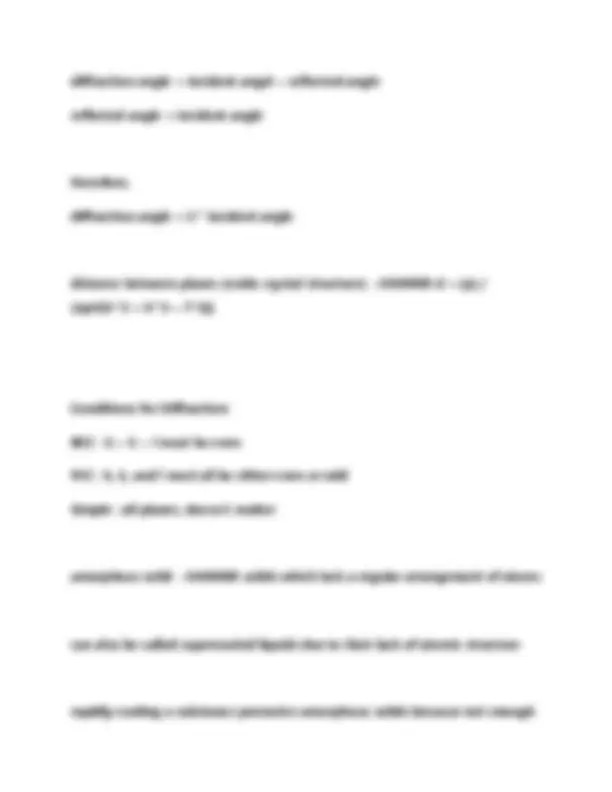
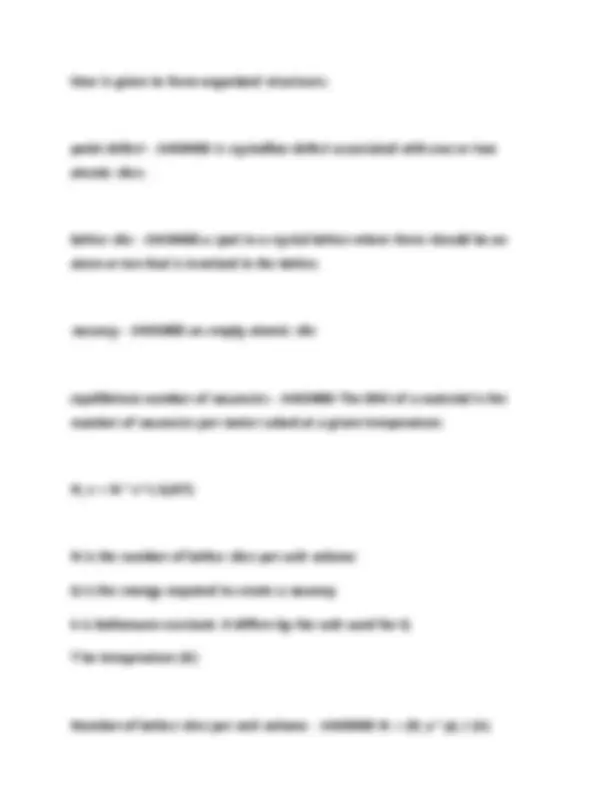
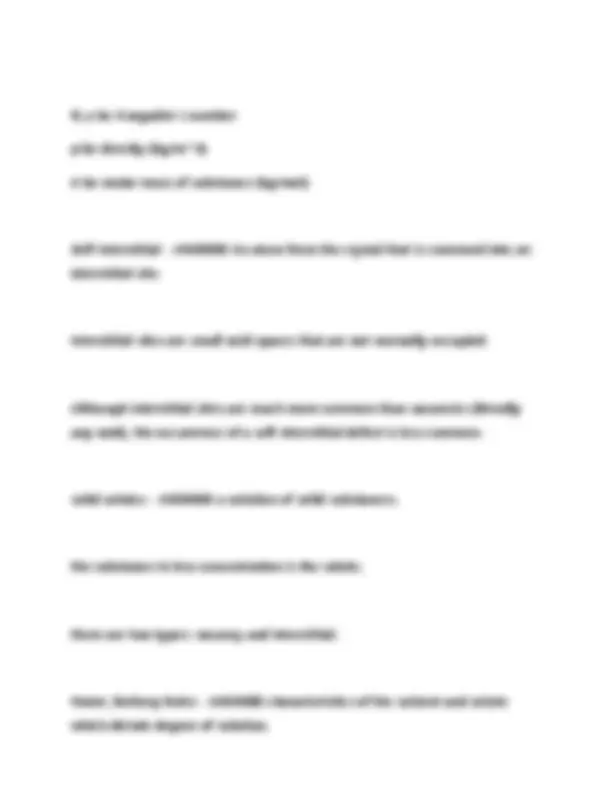
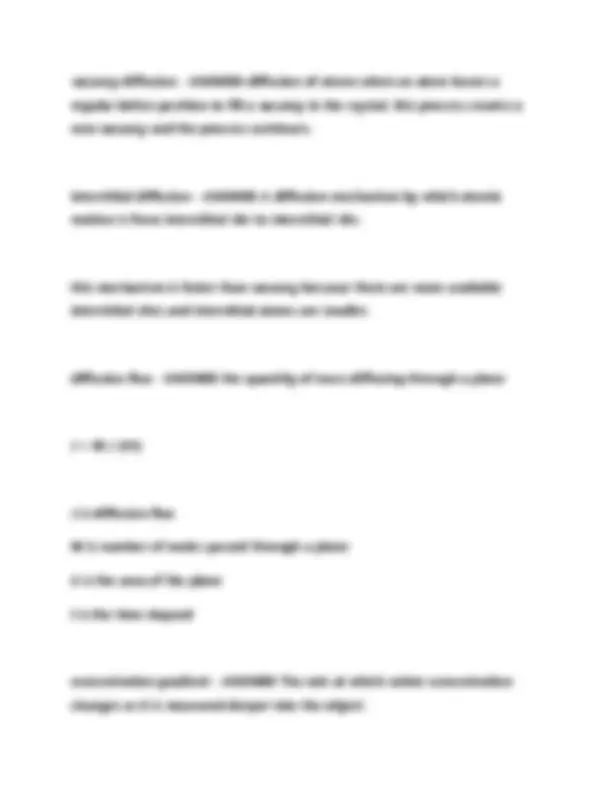
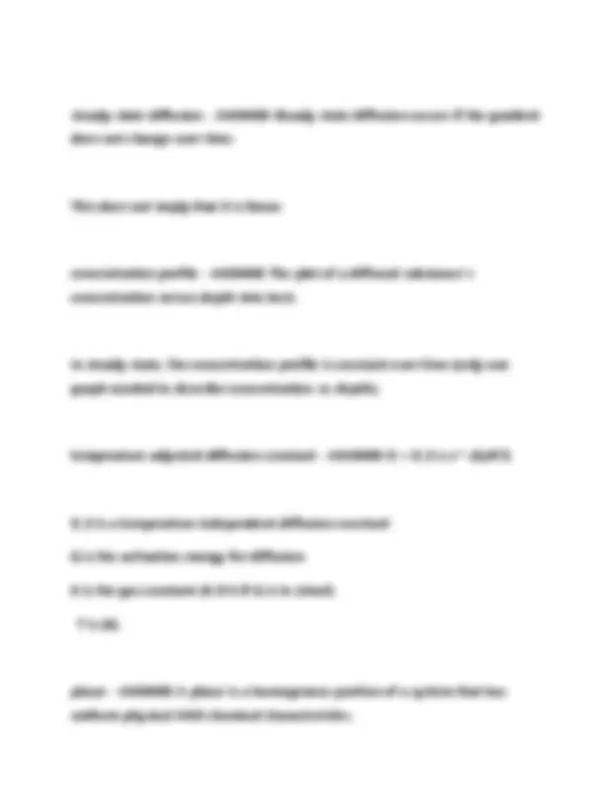
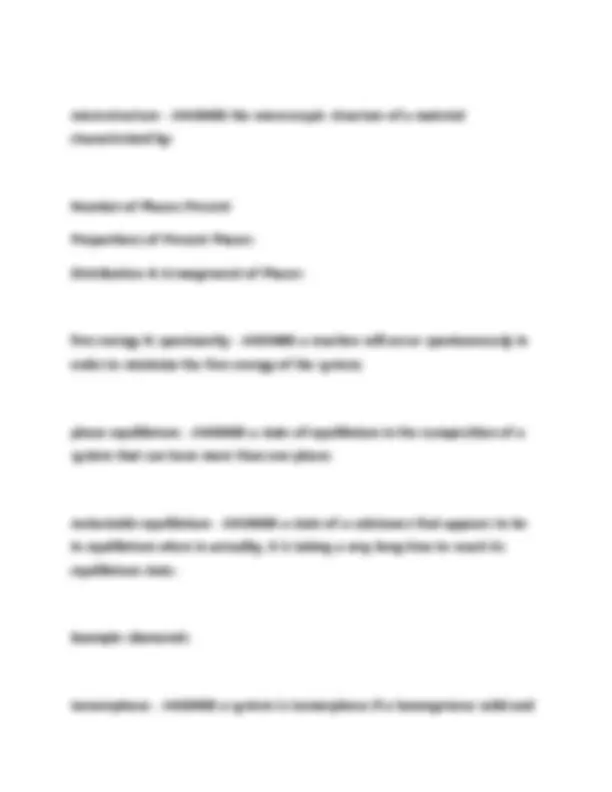
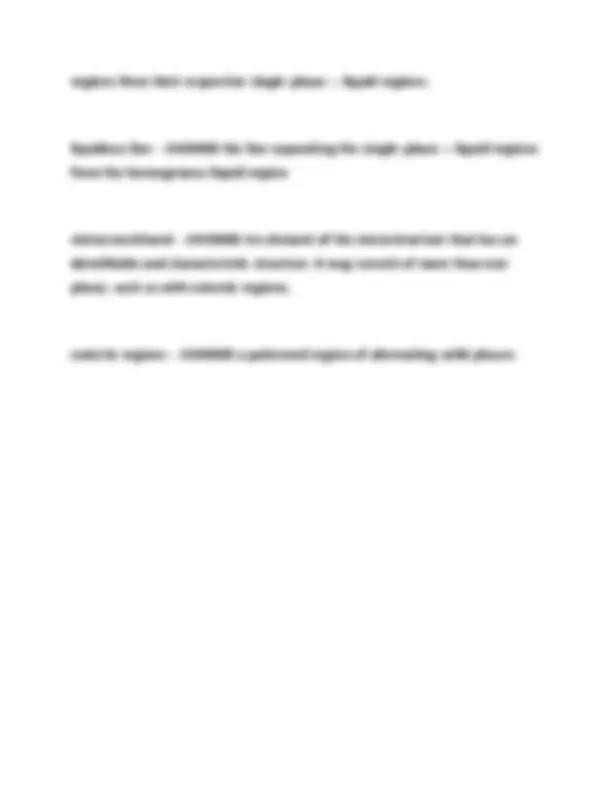


Study with the several resources on Docsity

Earn points by helping other students or get them with a premium plan


Prepare for your exams
Study with the several resources on Docsity

Earn points to download
Earn points by helping other students or get them with a premium plan
Community
Ask the community for help and clear up your study doubts
Discover the best universities in your country according to Docsity users
Free resources
Download our free guides on studying techniques, anxiety management strategies, and thesis advice from Docsity tutors
MTL200 - Final Exam Latest Update With Correct Answers.
Typology: Exams
1 / 18

This page cannot be seen from the preview
Don't miss anything!











Atomic mass vs. atomic weight - ANSWER Mass : the sum of Protons and Neutrons of the element. Weight : Weighted avgerage of the isotopes of given element quantum numbers (name, visual meaning, symbol) - ANSWER Principle : Shell -- energy level / size (n) Angular Momentum : Subshell -- cloud shape (l) Magnetic : Orbital -- cloud shape variant (m_{l}) Spin : Spin -- electron spin (up/down) (m_{s}) subshell letters (in order and shape name) - ANSWER s (sphere), p (dumbbell), d (pedal), f (double pedal) how to setup orbital order - ANSWER orbitals in the same column, energy levels in the same row. shave off the top corner. Group 1, Group 2, Group 7, Group 8 electron config values - ANSWER s^1, s^2, p^5, p^ monovalent, divalent - ANSWER monovalent: 1 electron needed to gain or lose to fill valence divalent: 2 electrons needed to gain or lose to fill valence
equilibrium spacing - ANSWER distance between two atoms where net force is zero. minimum energy level. bonding energy - ANSWER the amount of energy needed to separate two charged particles at an infinite distance. ionic bonding properties and reason - ANSWER melting point : strong bonds brittle : rigid/fixed atom arrangement electrically insulated : very stable electrons metallic bonding and ion core - ANSWER ion cores is the nucleus and non-valence electrons of an atom. metals are made of this. the valence electrons are shared amongst themselves. van der Waals forces - ANSWER very weak intermolecular forces of attraction IMFs in inert gasses - ANSWER only van der waals anions for hydrogen bonding - ANSWER fluorine, oxygen, chlorine metal-ionic bonds - ANSWER bonds of a substance with considerable ionic and metallic bonds. occurs when two metals with large electronegativities are together. as electronegativity difference increases, so does percent ionic bond. major unit cells - ANSWER FCC, BCC, HCP, Simple FCC measurements & characteristics - ANSWER Reference Measurement: 4r is
Polymorphism - ANSWER The ability of a substance two have two or more possible crystal structures. Ex : carbon (diamond, graphite) Allotropy - ANSWER Polymorphism in an elemental solid (solid made of one element) lattice parameters - ANSWER the lengths and sides of the unit cell and the angles between those sides 7 crystal structures shape & description - ANSWER cubic equal edge lengths, equal angles hexagonal perfect hexagonal top & bottom; height is ambiguous tetragonal square-based prism rhombohedral all edges equal; only two angles equal results in slanted cube orthorhombic rectangular prism with no equal edges monoclinic all different edges; 2 same angles triclinic
all different edges; all different angles hexagonal crystal systems - ANSWER parameters a : hexagon radius (also edge length) = 2r c : hexagon height measurements volume : (3 sqrt(3))/(2) x a^2 x c point coordinate notation & formulae (in terms of parameters) - ANSWER qrs q = x distance / a r = y distance / b s = z distance / c crystallographic direction notation & formulae (in terms of parameters) - ANSWER [uvw] u = (x2 - x1)/a u = (y2 - y1)/b u = (z2 - z1)/c all parameters must be in the smallest whole number ratio drawing directions (instructions) - ANSWER 1. determine the index presenting a full edge length. It is the largest index value.
Atoms who were not fully cut contribute the fraction of the radius which was penetrated. planar density formula - ANSWER PD = (num of atoms cut along a center plane) / (area of plane) Atoms who were not fully cut contribute the fraction of the circular imprint left on the plane difference between HCP & FCC crystal stacks - ANSWER HCP follows ABABAB stack FCC follows ABCABCABC stacks isotropic substance - ANSWER a material that has the same property in all directions of measurement
polycrystalline structures & anisotropy - ANSWER polycrystalline structures are very isotropic because small grains in many directions make all directions of measurement equal.
textured substance - ANSWER a substance is textured if it is the opposite of isotropic.
Bragg's Law - ANSWER n λ =2dsin θ
θ is the incident angle.
diffraction angle = incident angel + reflected angle reflected angle = incident angle
therefore, diffraction angle = 2 * incident angle
distance between planes (cubic crystal structure) - ANSWER d = (a) / (sqrt(h^2 = k^2 + l^2))
Conditions for Diffraction: BCC : k + k + l must be even FCC : h, k, and l must all be either even or odd Simple : all planes, doesn't matter
amorphous solid - ANSWER solids which lack a regular arrangement of atoms
can also be called supercooled liquids due to their lack of atomic structure
rapidly cooling a substance promotes amorphous solids because not enough
N_a be Avogadro's number p be density (kg/m^3) A be molar mass of substance (kg/mol)
Self-Interstitial - ANSWER An atom from the crystal that is crammed into an interstitial site.
Interstitial sites are small void spaces that are not normally occupied.
Although interstitial sites are much more common than vacancies (literally any void), the occurrence of a self-interstitial defect is less common.
solid solutes - ANSWER a solution of solid substances.
the substance in less concentration is the solute.
there are two types: vacancy and interstitial.
Hume_Rothery Rules - ANSWER characteristics of the solvent and solute which dictate degree of solution.
atomic size factor appreciable solution occurs when the difference in atomic radii is no more than +_15%
crystal structure having the same crystal structure is important.
electronegativity difference a larger difference promotes interstitial solution.
valences metals with higher valencies tend to dissolve better.
Linear Intercept Grain Size Fromula - ANSWER l = L/(PM)
L is the total length of lines (no magnification) P is the total number of grain boundaries intercepted M be the lens magnification
vacancy diffusion - ANSWER diffusion of atoms when an atom leaves a regular lattice position to fill a vacancy in the crystal, this process creates a new vacancy and the process continues.
interstitial diffusion - ANSWER A diffusion mechanism by which atomic motion is from interstitial site to interstitial site.
this mechanism is faster than vacancy because there are more available interstitial sites and interstitial atoms are smaller.
diffusion flux - ANSWER the quantity of mass diffusing through a plane
J = M / (At)
J is diffusion flux M is number of moles passed through a plane A is the area of the plane t is the time elapsed
concentration gradient - ANSWER The rate at which solute concentration changes as it is measured deeper into the object.
steady-state diffusion - ANSWER Steady-state diffusion occurs if the gradient does not change over time.
This does not imply that it is linear.
concentration profile - ANSWER The plot of a diffused substance's concentration versus depth into host.
In steady-state, the concentration profile is constant over time (only one graph needed to describe concentration vs. depth).
temperature adjusted diffusion constant - ANSWER D = D_0 x e^-(Q/RT)
D_0 is a temperature independent diffusion constant Q is the activation energy for diffusion R is the gas constant (8.314 if Q is in J/mol) T is (K)
phase - ANSWER A phase is a homogenous portion of a system that has uniform physical AND chemical characteristics.
liquid can form for all composition ratios.
regions of non-isomorphous phase diagram - ANSWER alpha : homogenous solid solution with high concentration of substance B beta : homogenous solid solution with high concentration of substance A L : homogenous liquid
alpha and beta can mix, but they remain distinct phases
multi-phase substance composition (instructions) - ANSWER 1. draw a tie line
Lever Rule - ANSWER A technique for determining the amount of each phase
in a two-phase system
cored structure - ANSWER a type of microstructure that occurs during rapid solidification or non-equilibrium cooling of a metal
cored grains form. the inner part of the grain has high concentrations of a substance. this concentration reduced on more exterior layers.
solvus line - ANSWER the line separating single-phase alpha or beta from the alpha + beta region.
solidus line - ANSWER the line separating the single phase alpha or beta